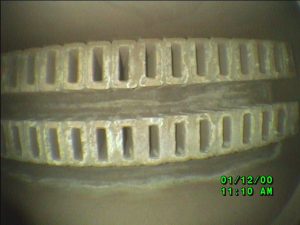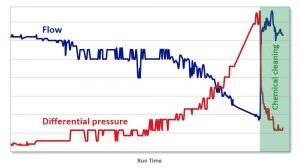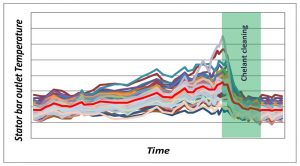Tech Info
Tech Info
In the presence of oxygen, copper in water reacts by formation of oxides. The two species cuprous and cupric oxides are formed in equilibrium, mainly depending on the oxygen concentration present. These oxides dissolve, migrate and redeposit (ideally in the demineralizer), no matter which oxide is formed. Over time and depending on the water chemistry involved, the oxides can start plugging up the copper hollow conductors in the generator.
Signs of plugging
Look for flow restriction patterns in flow / delta p trends. Not all bars plug up evenly, so individual Teflon hose temperatures are useful in that they not only show trends in temperatures, but also increasing temperature gaps amongst the thermocouples. With our advanced cleaning method, we can non-destructively remove the copper oxides from the system and return the cooling water system to its full cooling capacity. This can be done while the generator is operating (online), or as part of a planned outage when it is offline. Preventive maintenance cleanings can save a plant from a possible forced outage. Such cleanings should be scheduled according to specific circumstances.
Signs of plugging
FAQ
FAQ
We are happy to answer any questions not covered here; please contact us!
Q: How long does an offline and online cleaning usually take?
A: Depending on several parameters, an offline cleaning usually takes about 4 days while an online cleaning takes 10-15 days.
Q: Why does the online cleaning take longer than the offline?
A: The chemical concentration for the online cleaning is restricted by the conductivity limits during operation (usually appr. 10 µS/cm).
Q: Does chemical cleaning make the coil more sensitive to re-occurrence of plugging?
A: If properly done, chemical cleaning does not increase the sensitivity for fouling. However, cleaning removes only the symptoms but not the root cause of hollow conductor fouling. Of the chemical cleanings we have made, about 70% were once-only cleanings. With most of the remaining 30% who required repeat cleanings, persistent defects in system design or operation had been identified.
Q: How does a load change interfere with the online cleaning?
A: Load changes do not interfere with the cleaning.
Q: Did you ever observe a crud burst?
A: We never observed a crud burst. Our process is applied very deliberately to prevent such events, and our expertise helps adjusting it within safe parameters. We did see machines that plugged up worse or even damaged after other cleaning processes were applied.
Q: Would you rather recommend high oxygen or low oxygen water treatment?
A: All of the chemical regimes have their advantages and disadvantages. If you have stable conditions within the specifications in the CIGRE guidelines, do not change anything.
Q: What limitations does the process have?
A: Our process is very effective on copper oxides; other flow restrictions may need additional measures.
We are happy to answer any questions not covered here; please contact us!
Q: How long does an offline and online cleaning usually take?
A: Depending on several parameters, an offline cleaning usually takes about 4 days while an online cleaning takes 10-15 days.
Q: Why does the online cleaning take longer than the offline?
A: The chemical concentration for the online cleaning is restricted by the conductivity limits during operation (usually appr. 10 µS/cm).
Q: Does chemical cleaning make the coil more sensitive to re-occurrence of plugging?
A: If properly done, chemical cleaning does not increase the sensitivity for fouling. However, cleaning removes only the symptoms but not the root cause of hollow conductor fouling. Of the chemical cleanings we have made, about 70{83c70a5ecd6cbba97170d859e6cf4261a9f2a1019f5f4322afdb96e05b198275} were once-only cleanings. With most of the remaining 30{83c70a5ecd6cbba97170d859e6cf4261a9f2a1019f5f4322afdb96e05b198275} who required repeat cleanings, persistent defects in system design or operation had been identified.
Q: How does a load change interfere with the online cleaning?
A: Load changes do not interfere with the cleaning.
Q: Did you ever observe a crud burst?
A: If not carefully controlled and without proper supervision, crud bursts that plug up other hollow conductors or the filters might occur. However, with our careful control of the process, we have never experienced such a crud burst.
Q: Would you rather recommend high oxygen or low oxygen water treatment?
A: All of the chemical regimes have their advantages and disadvantages. If you have stable conditions within the specifications in the CIGRE guidelines, do not change anything.
Q: What limitations does the process have?
A: We have two limitations: first, as with any type of chemical cleaning, we need a little flow through the cooling water channel, so that our chemicals can reach the copper oxides. Second, our method is very efficient on copper oxides, however, foreign material will not be removed.




